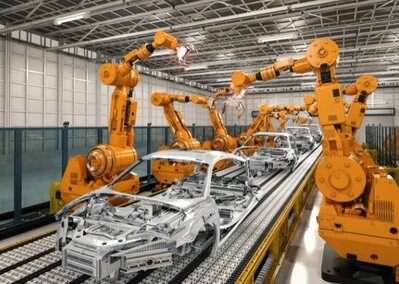Closer, safer: how the automotive industry can readjust by changing from delocalization to an industrial supply chain model

01/11/2022
A chip manufactured in China, transported by ship or plane to Europe and then installed in a car to be sold in the United States. This is a small example of globalization applied to the automotive sector. A well-established supply chain, which was disrupted by the pandemic, the material crisis – with chip shortages unfortunately being a major issue – and finally the war in Ukraine. The result: up to 500 ships moored at the port of Shanghai without permission to dock or set sail, cable manufacturers at a standstill because of the conflict.
So the well-oiled supply chain that until recently allowed the world to turn, has now become a brake, slowing down production and sales. The responses from the automotive industry all went at different speeds, but all in a very specific direction: reshoring, i.e. moving production as close as possible to where the cars are assembled. So new trade disruptions due to the most disparate reasons are no longer something to worry about.
Between chips and recycling
Returning to the subject of chips, China is the world leader, but this could change in the coming years. For some time, information technology giants have been planning to implement new production lines in Europe and the United States in order to be able to supply the manufacturers that rely on them quickly and smoothly. Some are already operational and are already planning to expand over the next few years, making investments of hundreds of millions of dollars; others are waiting for the "green light" from the competent authorities.
Italy could also play an important role in this. For several weeks, it appears that a large Silicon Valley company is apparently intending to invest 4.5 billion euros to build a chip manufacturing facility in Veneto or Piedmont. This would also make Italy a player in the semiconductor industry, drastically shortening the supply chain for the factories in the country.
Another subject that is becoming increasingly common in the programs of the principal motorist groups is that of the circular economy, to create a value chain capable of recycling and reusing materials from cars that are no longer used. To do this, new factories will be required, where the new models will be reassembled and sold.
Another issue that hit the headlines when the war in Ukraine broke out was the supply of cables, a sector in which Kiev was the European leader, but which has now been severely disrupted by the conflict. Yet another emergency for the auto supply chain with numerous manufacturers initially running for cover by turning to other suppliers around the world, but with the aim of bringing everything closer as far as possible to avoid future problems.
The battery issue
The ever-increasing importance of electric cars in the price lists of most brands – also accelerated by the 2035 deadline, the year in which Europe planned to stop selling models with combustion engines – then raises the most problematic issue of all: the production of batteries. China is a leader in the sale of zero-emission cars and 77% of the lithium-ion batteries produced in 2021 come from there. A monopoly, to which Europe and the United States have started to respond by designing numerous gigafactories (factories dedicated to the production of batteries for electric cars) within their own borders.
Again, Italy also wants to be a part of this and thanks to investments by both automotive groups and industries in the energy sector, there are 3 projects to build new factories that will be implemented over the coming years. In total, there are plans for about forty gigafactories that have been announced or are already under construction in Europe.
So the well-oiled supply chain that until recently allowed the world to turn, has now become a brake, slowing down production and sales. The responses from the automotive industry all went at different speeds, but all in a very specific direction: reshoring, i.e. moving production as close as possible to where the cars are assembled. So new trade disruptions due to the most disparate reasons are no longer something to worry about.
Between chips and recycling
Returning to the subject of chips, China is the world leader, but this could change in the coming years. For some time, information technology giants have been planning to implement new production lines in Europe and the United States in order to be able to supply the manufacturers that rely on them quickly and smoothly. Some are already operational and are already planning to expand over the next few years, making investments of hundreds of millions of dollars; others are waiting for the "green light" from the competent authorities.
Italy could also play an important role in this. For several weeks, it appears that a large Silicon Valley company is apparently intending to invest 4.5 billion euros to build a chip manufacturing facility in Veneto or Piedmont. This would also make Italy a player in the semiconductor industry, drastically shortening the supply chain for the factories in the country.
Another subject that is becoming increasingly common in the programs of the principal motorist groups is that of the circular economy, to create a value chain capable of recycling and reusing materials from cars that are no longer used. To do this, new factories will be required, where the new models will be reassembled and sold.
Another issue that hit the headlines when the war in Ukraine broke out was the supply of cables, a sector in which Kiev was the European leader, but which has now been severely disrupted by the conflict. Yet another emergency for the auto supply chain with numerous manufacturers initially running for cover by turning to other suppliers around the world, but with the aim of bringing everything closer as far as possible to avoid future problems.
The battery issue
The ever-increasing importance of electric cars in the price lists of most brands – also accelerated by the 2035 deadline, the year in which Europe planned to stop selling models with combustion engines – then raises the most problematic issue of all: the production of batteries. China is a leader in the sale of zero-emission cars and 77% of the lithium-ion batteries produced in 2021 come from there. A monopoly, to which Europe and the United States have started to respond by designing numerous gigafactories (factories dedicated to the production of batteries for electric cars) within their own borders.
Again, Italy also wants to be a part of this and thanks to investments by both automotive groups and industries in the energy sector, there are 3 projects to build new factories that will be implemented over the coming years. In total, there are plans for about forty gigafactories that have been announced or are already under construction in Europe.





















